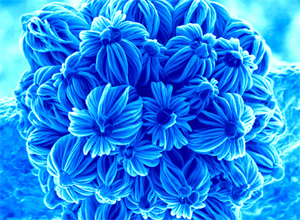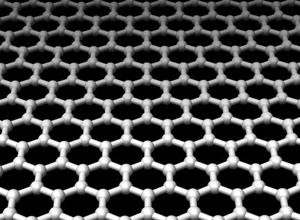This page has been archived and is no longer updated

At a lecture of the American Physical Society in 1959, physicist Richard Feynman proposed that one day humankind could create machines composed of several individually manipulated molecules or atoms, and these machines could be constructed by tools that were only slightly larger. Why would this possibility be more than just a curiosity, more than a modern-day analogue to medieval micrography, for example? Both he and his audience knew that electrons behave differently at such a small scale — less than one hundred billionth of a meter (nanometer) — from how they behave at the scale of most present-day machines. For instance, when materials are constructed at a smaller scale, because there are fewer paths that electrons can take through their molecular structure they are more conductive of heat and electricity. Recognizing the extraordinary possibilities inherent in harnessing this and other properties, engineers, physicists, chemists, and biologists over the subsequent decades began to explore how nanotechnologies — technologies that utilize the properties of individual atoms or molecules — could improve information technology, industrial design, and biomedicine.
One of the great achievements of nanoscience to date is the development of graphene, a manmade sheet of interlinked, honeycomb-patterned carbon atoms that is exactly one carbon atom thick. Due to its thinness on the one hand and the uniformity of the honeycomb arrangement on the other, graphene is both extremely light and extremely strong. In fact, amazingly enough, graphene is 200 times stronger than steel. In the words of Columbia University's mechanical engineering professor James Hone, "It would take an elephant, balanced on a pencil, to break through a sheet of graphene the thickness of Saran Wrap." As a result, graphene greatly enhances the structural integrity and lifespan of materials that it is mixed or layered with, such as glass or plastic. Engineers today are busy finding innovative ways to mix graphene into the construction of much larger objects, including wind turbines and airplanes.
Graphene has a number of other intriguing properties. Its uniformity and structural perfection make it extremely electrically conductive, introducing the possibility of creating graphene-based transistors that are ten times faster than the silicon-based transistors in current computer processors. Similarly, a carbon nanotube, which can be thought of as a graphene sheet rolled into a straw, is a highly conductive microscopic wire that can be combined with other nanotubes to form tiny, powerful electrical circuits. Scientists and engineers have been working to find ways to adapt these properties of graphene and nanotubes in order to build massively powerful and efficient computer processors, power grids, and portable electronic devices.
The number of nanoscientific innovations outside of graphene research is also increasing. For example, Francesco Stellacci and Darrell Irvine at the Massachusetts Institute of Technology have developed a technique to use nano-scale particles to deliver pharmaceuticals directly into diseased cells, and Jeff Tza-Huei Wang's lab at Johns Hopkins University has developed a way to use nanoparticles called quantum dots to more sensitively screen for critical diseases. Outside of medicine, nanometer-thick coatings can be applied to surfaces to help them better reflect or absorb light, ultimately improving windows, mirrors, and solar panels. Nanotechnology has even allowed scientists to optimize microscopes that allow them to more clearly see . . . nanoparticles.
Yet, as is so often the case with the development of powerful new approaches to traditional materials and processes, many leading thinkers have grave concerns about the implications of nanotechnology. Since a nanotechnology-based object can be so small, how can we tell where it is, or where it's going? Can nanoparticles accumulate without our knowledge in our water supplies, crops, and lungs? What would be the consequences of this? As a result of these concerns, governments are actively pursuing ways to control the manufacture and uses of nanotechnology. Yet its great potential for innovation means that equally powerful constituencies are pushing for broader dispersion of nanotechnology. Clearly, as of March 2010, we are only at the beginning of charged and impactful debate. We hope that this Spotlight will launch a lifelong interest into a field of research that may come to represent one of the great triumphs of 21st century science.
Image: © Ghim Wei Ho and Prof. Mark Welland, Nanostructure Center, University of Cambridge. All rights reserved.
The NSF provides answers to the central questions about nanotechnology.
Click through the main categories: what does nanotechnology do for us?
Read educational materials provided by the collaboration of US federal agencies.
In 1959, Richard Feyman addressed the potential of nanotechnology and urged his colleagues to consider going smaller than they ever had before.
Early research in optics enabled visualization at the atomic scale. An STM electron microscope can provide 3-D images of a sample by scanning its structure with a stylus.
Read about improved visualization of nanoscale objects with the Atomic Force Microscope. This technology enables scans of almost any surface using lasers and deflection.
Watch a video from KQED about what nanotechnology means for global warming and disease.
In a brief list, learn how nanotechnology has changed how we can meet a variety of technological demands, from energy to health.
Read about the 2004 discovery that may revolutionize electronics and materials science.
Watch this video about how researchers have drawn inspiration from gecko feet to create climbing robots.
Read how solar panels have been updated with nanotechnology that makes them cheaper and better.
Discover how nanotechnology can improve the preservation of ancient texts, and revolutionize archiving processes.
The NIH animates and describes nanotechnology's use in medicine.
See how tiny structures known as quantum dots help detect cancer.
Read a comprehensive review of the advantages and concerns surrounding the use of nanoparticle drugs.
Basic research in flies reveals that nanoparticles may pose health risks.
Listen to an interview with from a leading nanotechnology watcher.
A database of risk assessment is compiled by ICON, the International Council on Nanotechnology.
